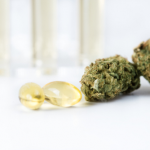Cannabis studies still leave a lot to be desired.
Cannabis research is fantastic, and cannabis science is really cool. And it looks like we still need a lot more of both, because right now, results from cannabis studies leave a lot to be desired. Some of them can even be touted by prohibitionists who—surprise, surprise—don’t take all the information into consideration.
That’s the case with a series of ongoing studies recently reported on by NPR’s Morning Edition, which interviewed Matthew Springer, a biologist and cardiology professor at the University of California, San Francisco. In the most San Francisco thing ever, Dr. Springer found inspiration at a Paul McCartney concert at AT&T Park, coming to the realization that the people lighting up during the show weren’t smoking cigarettes, but rather—weed! In San Francisco, at a Paul McCartney concert. You’re ruining it for the rest of us, hippies!
Instead of phoning law enforcement or screaming for help, the doctor found inspiration in these rule-defying, counterculture types. Springer was already performing studies on the effects of secondhand tobacco smoke upon rats in his lab at UCSF (he found it made them sing jazz standards in a huskier, sexier voice), and decided to do the same thing with cannabis, using joints to measure the effects of secondhand cannabis smoke.
Springer’s tobacco studies measured the ability of the rats’ arteries to expand after prolonged exposure to smoke. More blood means healthier arteries, but when a person (or a rat) smokes one cigarette after another, the arterial walls can become permanently damaged, causing heart attacks, strokes, and blood clots.
For the cannabis experiment, a lit joint of 0.9 grams was placed into a 20-liter plexiglass box and mechanically “smoked” for three minutes at the rate of a “puff” every second, filling the box with smoke. Excess smoke was then vented from the chamber to obtain the desired starting concentration. A ketamine-anesthetized rat was placed into the box, its nose inserted into a gasket, and exposed to the smoke for 30 minutes (sounds like the rejected plot line for Ratatouille 2: Remy’s K-Hole Adventure).
The tobacco study revealed that after 30 minutes, the rat’s arteries would return to their normal function. With cannabis, however, it took 90 minutes—which is also about the length of time it took for write-ups crying “OMG cannabis smoke is three times worse than tobacco smoke!” to show up online.
But there are a few things to consider.
First of all: Cannabis is an illegal drug under federal law, and the study used federal funds. So to stay compliant, it had to use weed supplied by the National Institute on Drug Abuse (NIDA). Researchers have complained for years about the quality of NIDA cannabis—that it often resembles a “ground-up green powder,” tests positive for molds, contains lower-than-requested THC levels, and isn’t grown from widely available strains. No one is smoking this type of weed in the real world, because no one is growing it.
Also, the joints were 4.5 percent THC, which is so low, it’s practically industrial hemp. Again: Nobody smokes this.
Futhermore, cannabis usually isn’t smoked in the same manner as tobacco, and a nearly one-gram joint isn’t something an individual typically consumes in a single sitting, unlike a cigarette.
And lastly, most humans won’t do what Smokey the Rat did and smoke garbage weed nonstop for 30 minutes with their nose inserted through a gasket after being anesthetized with ketamine.
Look, secondhand smoke is annoying and unhealthy. I don’t ever want to be exposed to secondhand tobacco smoke, and I can understand why there are people who don’t want to be exposed to secondhand cannabis smoke. (Children shouldn’t be exposed to either kind of smoke—ever.) And yes, there are good methods of enjoying cannabis, such as vaping and eating, that greatly reduce respiratory aggravation and eliminate secondhand smoke. But that’s no reason to stifle social consumption spaces, particularly outdoor sites.
The study that NPR reported on is only a introduction to the question of secondhand cannabis smoke. Cannabis science is still in its early days, and remains restrictive and underfunded—not to mention that it often requires the use of federally mandated, moldy, compost-destined floor sweepings being passed off as laboratory-grade cannabis. We need to allow researchers unfettered access to the kinds of cannabis that are actually being used. Reexamining how and where real-world cannabis is consumed is the best way to give us truer insight into the real effects of secondhand cannabis smoke.
(209)





Leave A Reply